Business Finance Report: Performance Analysis of T-shirt Ltd
VerifiedAdded on 2023/01/06
|16
|3649
|40
Report
AI Summary
This report provides a comprehensive analysis of the financial performance of T-shirt Ltd, covering key aspects of business finance. It begins with an introduction that highlights the importance of financial management and its impact on business operations. The main body of the report is struct...

Business Finance
Paraphrase This Document
Need a fresh take? Get an instant paraphrase of this document with our AI Paraphraser

Contents
INTRODUCTION...........................................................................................................................3
MAIN BODY..................................................................................................................................3
TASK 1........................................................................................................................................3
Analysis business performance of T-shirt Ltd.............................................................................3
TASK 2............................................................................................................................................8
Brief description related with financial information & management of cash of T-shirt Ltd.......8
TASK 3..........................................................................................................................................10
Explanation of budget and its essential techniques...................................................................10
CONLCUSION..............................................................................................................................12
REFRENCES.................................................................................................................................14
INTRODUCTION...........................................................................................................................3
MAIN BODY..................................................................................................................................3
TASK 1........................................................................................................................................3
Analysis business performance of T-shirt Ltd.............................................................................3
TASK 2............................................................................................................................................8
Brief description related with financial information & management of cash of T-shirt Ltd.......8
TASK 3..........................................................................................................................................10
Explanation of budget and its essential techniques...................................................................10
CONLCUSION..............................................................................................................................12
REFRENCES.................................................................................................................................14

INTRODUCTION
Business entities are expected to conduct their business operations efficiently by controlling their
financial capital. Finance is the flow of money from which the overall operations of the company
spread. It's the blood of the enterprise (Connolly and Bank, 2020). T-shirt Ltd has taken to
consider the importance of corporate finance. This report includes an overview of the results of
business by measuring and evaluating the financial ratio. This further describes the use of a
reliable and cash accounting system. This involves how efficiently administrators use the budget
to make plans and assess the potential value of income. The advantages of the registered public
association in the stock exchange have been defined in this report in an appropriate manner.
MAIN BODY
Part 1
1.1 Statement of profit and loss.
In order to measure the business success of an organisation’s employees, the financial ratio is
used to make it easier for them to consider differences in each item in a company's financial
statements.
The income statement or profit and loss document is among the company's balance sheet and
shows the company's revenue versus expenses over a given period of time. It illustrates how the
sales are transformed into the revenues and expenditure of the business (Lewis and Liu, 2020).
As far as T-shirt limited is concerned, it can be seen that the business is expecting a net deficit of
500 million in 2019 and a net profit of 372 million in the final year of 2018. This is attributed to
a higher degree of spending in the year 2019 relative to the year 2019. In order to allow a
thorough review of the income statement, below those main ratios is indicated, which are as
continues to follow:
Profitability ratio
Gross profit ratio
Gross profit ratio = GP/ Sales
*100
60.01% 45.02
Business entities are expected to conduct their business operations efficiently by controlling their
financial capital. Finance is the flow of money from which the overall operations of the company
spread. It's the blood of the enterprise (Connolly and Bank, 2020). T-shirt Ltd has taken to
consider the importance of corporate finance. This report includes an overview of the results of
business by measuring and evaluating the financial ratio. This further describes the use of a
reliable and cash accounting system. This involves how efficiently administrators use the budget
to make plans and assess the potential value of income. The advantages of the registered public
association in the stock exchange have been defined in this report in an appropriate manner.
MAIN BODY
Part 1
1.1 Statement of profit and loss.
In order to measure the business success of an organisation’s employees, the financial ratio is
used to make it easier for them to consider differences in each item in a company's financial
statements.
The income statement or profit and loss document is among the company's balance sheet and
shows the company's revenue versus expenses over a given period of time. It illustrates how the
sales are transformed into the revenues and expenditure of the business (Lewis and Liu, 2020).
As far as T-shirt limited is concerned, it can be seen that the business is expecting a net deficit of
500 million in 2019 and a net profit of 372 million in the final year of 2018. This is attributed to
a higher degree of spending in the year 2019 relative to the year 2019. In order to allow a
thorough review of the income statement, below those main ratios is indicated, which are as
continues to follow:
Profitability ratio
Gross profit ratio
Gross profit ratio = GP/ Sales
*100
60.01% 45.02
You're viewing a preview
Unlock full access by subscribing today!
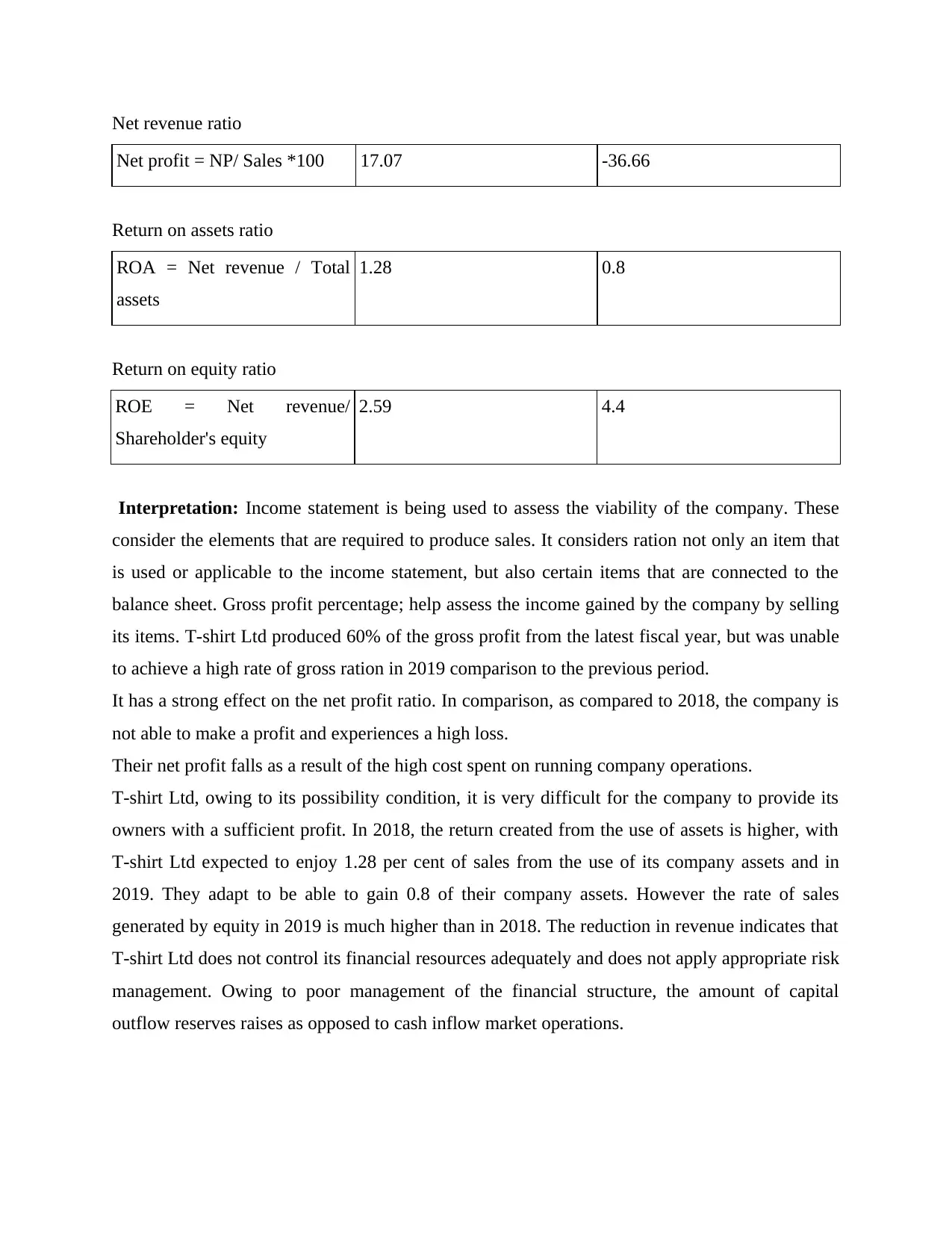
Net revenue ratio
Net profit = NP/ Sales *100 17.07 -36.66
Return on assets ratio
ROA = Net revenue / Total
assets
1.28 0.8
Return on equity ratio
ROE = Net revenue/
Shareholder's equity
2.59 4.4
Interpretation: Income statement is being used to assess the viability of the company. These
consider the elements that are required to produce sales. It considers ration not only an item that
is used or applicable to the income statement, but also certain items that are connected to the
balance sheet. Gross profit percentage; help assess the income gained by the company by selling
its items. T-shirt Ltd produced 60% of the gross profit from the latest fiscal year, but was unable
to achieve a high rate of gross ration in 2019 comparison to the previous period.
It has a strong effect on the net profit ratio. In comparison, as compared to 2018, the company is
not able to make a profit and experiences a high loss.
Their net profit falls as a result of the high cost spent on running company operations.
T-shirt Ltd, owing to its possibility condition, it is very difficult for the company to provide its
owners with a sufficient profit. In 2018, the return created from the use of assets is higher, with
T-shirt Ltd expected to enjoy 1.28 per cent of sales from the use of its company assets and in
2019. They adapt to be able to gain 0.8 of their company assets. However the rate of sales
generated by equity in 2019 is much higher than in 2018. The reduction in revenue indicates that
T-shirt Ltd does not control its financial resources adequately and does not apply appropriate risk
management. Owing to poor management of the financial structure, the amount of capital
outflow reserves raises as opposed to cash inflow market operations.
Net profit = NP/ Sales *100 17.07 -36.66
Return on assets ratio
ROA = Net revenue / Total
assets
1.28 0.8
Return on equity ratio
ROE = Net revenue/
Shareholder's equity
2.59 4.4
Interpretation: Income statement is being used to assess the viability of the company. These
consider the elements that are required to produce sales. It considers ration not only an item that
is used or applicable to the income statement, but also certain items that are connected to the
balance sheet. Gross profit percentage; help assess the income gained by the company by selling
its items. T-shirt Ltd produced 60% of the gross profit from the latest fiscal year, but was unable
to achieve a high rate of gross ration in 2019 comparison to the previous period.
It has a strong effect on the net profit ratio. In comparison, as compared to 2018, the company is
not able to make a profit and experiences a high loss.
Their net profit falls as a result of the high cost spent on running company operations.
T-shirt Ltd, owing to its possibility condition, it is very difficult for the company to provide its
owners with a sufficient profit. In 2018, the return created from the use of assets is higher, with
T-shirt Ltd expected to enjoy 1.28 per cent of sales from the use of its company assets and in
2019. They adapt to be able to gain 0.8 of their company assets. However the rate of sales
generated by equity in 2019 is much higher than in 2018. The reduction in revenue indicates that
T-shirt Ltd does not control its financial resources adequately and does not apply appropriate risk
management. Owing to poor management of the financial structure, the amount of capital
outflow reserves raises as opposed to cash inflow market operations.
Paraphrase This Document
Need a fresh take? Get an instant paraphrase of this document with our AI Paraphraser

1.2 Statement of financial position.
The management department frequently uses the balance sheet ration to evaluate the impact of
each balance sheet item on the results of company entities (Popescu and Popescu, 2019).
Current ratio
Current ratio = CA/CL 0.42 0.3
Quick ratio
QR = Quick asserts / Current
Liabilities
0.31 0.21
Efficiency ratio
Stock turnover ratio
Stock turnover = Cogs/
Average stock
9.43 6.2
Receivable turnover ratio
Receivable turnover = Net
credit sales / Average
receivables
9.63 4.47
Capital gearing ratio
Debt ratio
Debt ratio = Total debt / Total
assets
0.64 1.09
The management department frequently uses the balance sheet ration to evaluate the impact of
each balance sheet item on the results of company entities (Popescu and Popescu, 2019).
Current ratio
Current ratio = CA/CL 0.42 0.3
Quick ratio
QR = Quick asserts / Current
Liabilities
0.31 0.21
Efficiency ratio
Stock turnover ratio
Stock turnover = Cogs/
Average stock
9.43 6.2
Receivable turnover ratio
Receivable turnover = Net
credit sales / Average
receivables
9.63 4.47
Capital gearing ratio
Debt ratio
Debt ratio = Total debt / Total
assets
0.64 1.09
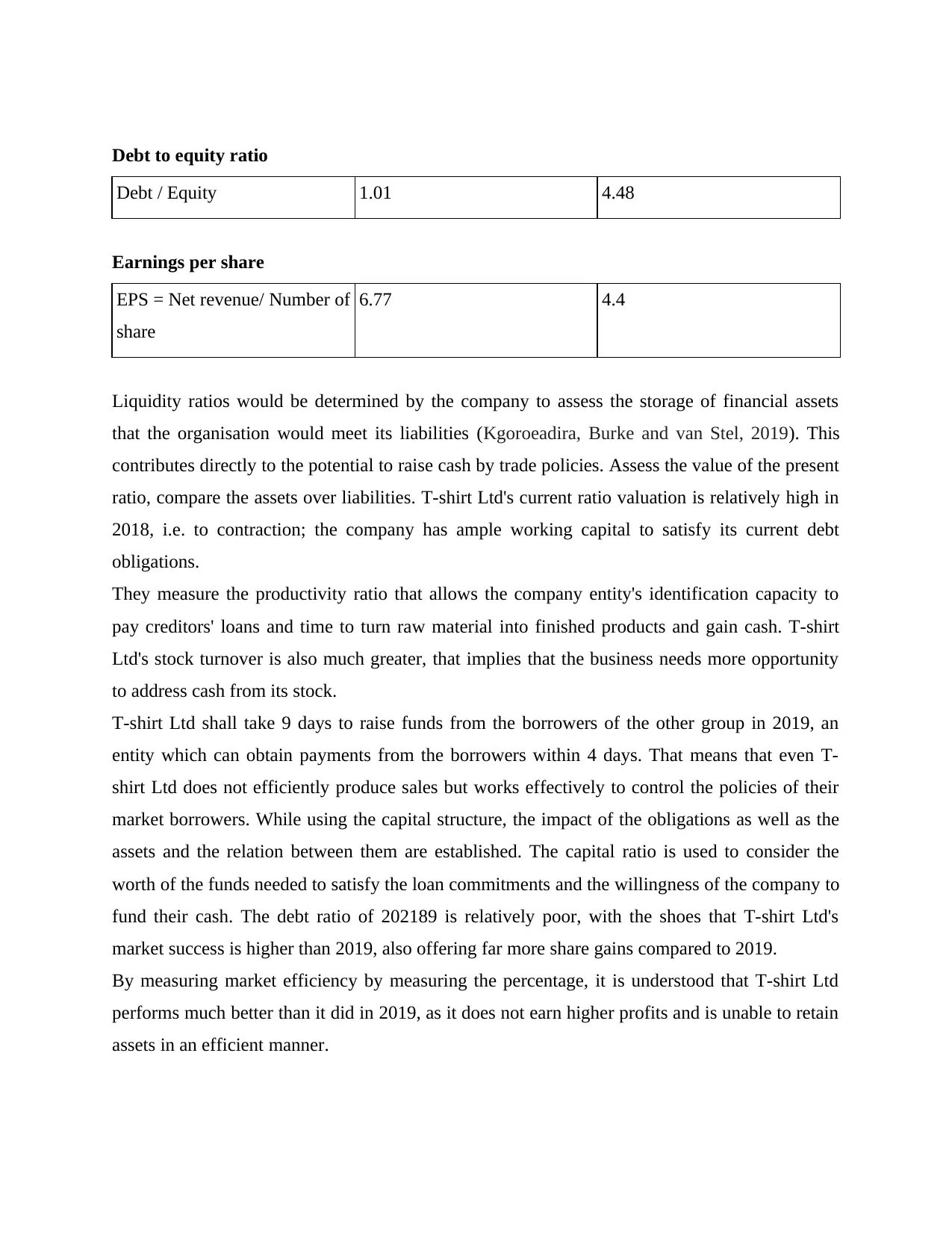
Debt to equity ratio
Debt / Equity 1.01 4.48
Earnings per share
EPS = Net revenue/ Number of
share
6.77 4.4
Liquidity ratios would be determined by the company to assess the storage of financial assets
that the organisation would meet its liabilities (Kgoroeadira, Burke and van Stel, 2019). This
contributes directly to the potential to raise cash by trade policies. Assess the value of the present
ratio, compare the assets over liabilities. T-shirt Ltd's current ratio valuation is relatively high in
2018, i.e. to contraction; the company has ample working capital to satisfy its current debt
obligations.
They measure the productivity ratio that allows the company entity's identification capacity to
pay creditors' loans and time to turn raw material into finished products and gain cash. T-shirt
Ltd's stock turnover is also much greater, that implies that the business needs more opportunity
to address cash from its stock.
T-shirt Ltd shall take 9 days to raise funds from the borrowers of the other group in 2019, an
entity which can obtain payments from the borrowers within 4 days. That means that even T-
shirt Ltd does not efficiently produce sales but works effectively to control the policies of their
market borrowers. While using the capital structure, the impact of the obligations as well as the
assets and the relation between them are established. The capital ratio is used to consider the
worth of the funds needed to satisfy the loan commitments and the willingness of the company to
fund their cash. The debt ratio of 202189 is relatively poor, with the shoes that T-shirt Ltd's
market success is higher than 2019, also offering far more share gains compared to 2019.
By measuring market efficiency by measuring the percentage, it is understood that T-shirt Ltd
performs much better than it did in 2019, as it does not earn higher profits and is unable to retain
assets in an efficient manner.
Debt / Equity 1.01 4.48
Earnings per share
EPS = Net revenue/ Number of
share
6.77 4.4
Liquidity ratios would be determined by the company to assess the storage of financial assets
that the organisation would meet its liabilities (Kgoroeadira, Burke and van Stel, 2019). This
contributes directly to the potential to raise cash by trade policies. Assess the value of the present
ratio, compare the assets over liabilities. T-shirt Ltd's current ratio valuation is relatively high in
2018, i.e. to contraction; the company has ample working capital to satisfy its current debt
obligations.
They measure the productivity ratio that allows the company entity's identification capacity to
pay creditors' loans and time to turn raw material into finished products and gain cash. T-shirt
Ltd's stock turnover is also much greater, that implies that the business needs more opportunity
to address cash from its stock.
T-shirt Ltd shall take 9 days to raise funds from the borrowers of the other group in 2019, an
entity which can obtain payments from the borrowers within 4 days. That means that even T-
shirt Ltd does not efficiently produce sales but works effectively to control the policies of their
market borrowers. While using the capital structure, the impact of the obligations as well as the
assets and the relation between them are established. The capital ratio is used to consider the
worth of the funds needed to satisfy the loan commitments and the willingness of the company to
fund their cash. The debt ratio of 202189 is relatively poor, with the shoes that T-shirt Ltd's
market success is higher than 2019, also offering far more share gains compared to 2019.
By measuring market efficiency by measuring the percentage, it is understood that T-shirt Ltd
performs much better than it did in 2019, as it does not earn higher profits and is unable to retain
assets in an efficient manner.
You're viewing a preview
Unlock full access by subscribing today!
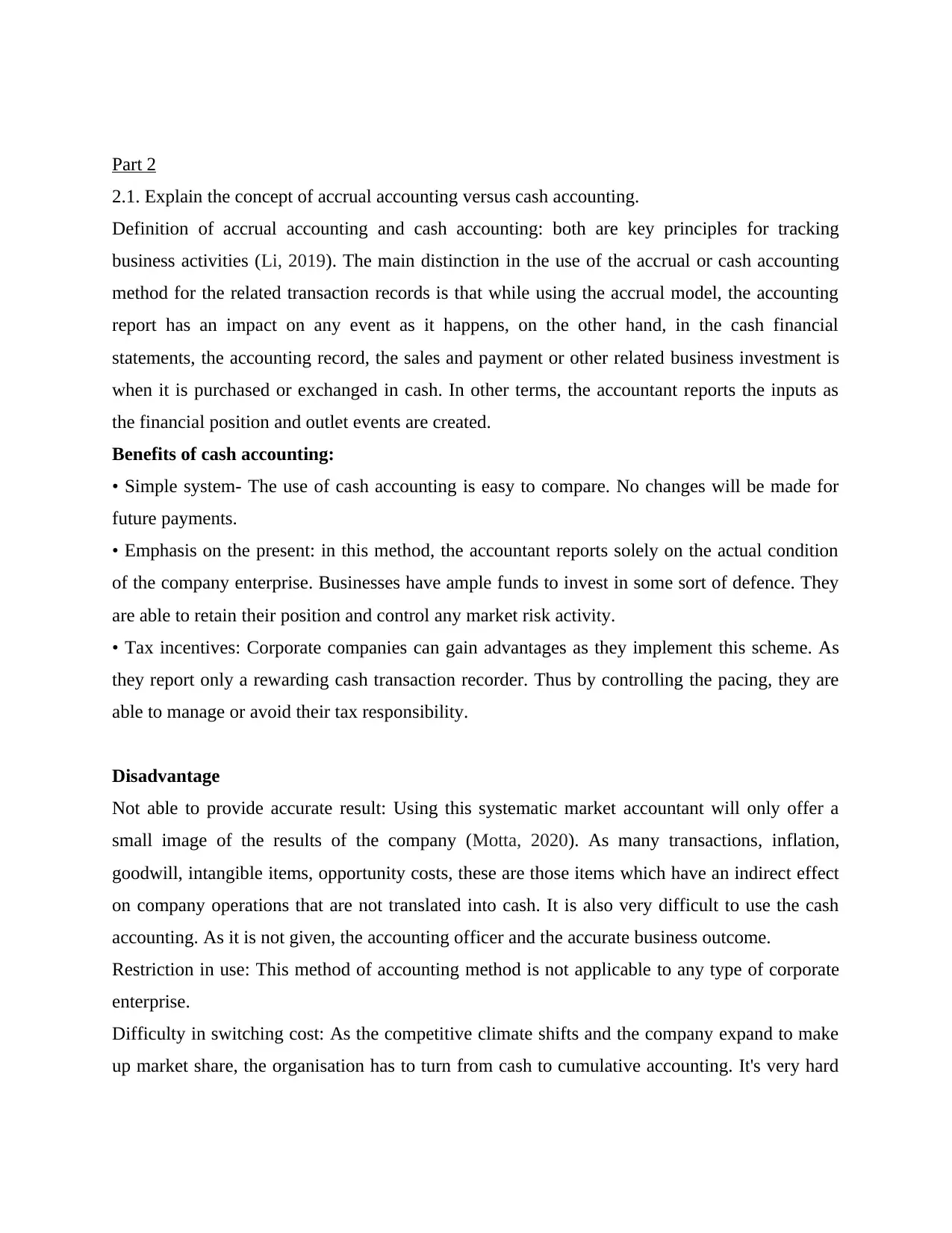
Part 2
2.1. Explain the concept of accrual accounting versus cash accounting.
Definition of accrual accounting and cash accounting: both are key principles for tracking
business activities (Li, 2019). The main distinction in the use of the accrual or cash accounting
method for the related transaction records is that while using the accrual model, the accounting
report has an impact on any event as it happens, on the other hand, in the cash financial
statements, the accounting record, the sales and payment or other related business investment is
when it is purchased or exchanged in cash. In other terms, the accountant reports the inputs as
the financial position and outlet events are created.
Benefits of cash accounting:
• Simple system- The use of cash accounting is easy to compare. No changes will be made for
future payments.
• Emphasis on the present: in this method, the accountant reports solely on the actual condition
of the company enterprise. Businesses have ample funds to invest in some sort of defence. They
are able to retain their position and control any market risk activity.
• Tax incentives: Corporate companies can gain advantages as they implement this scheme. As
they report only a rewarding cash transaction recorder. Thus by controlling the pacing, they are
able to manage or avoid their tax responsibility.
Disadvantage
Not able to provide accurate result: Using this systematic market accountant will only offer a
small image of the results of the company (Motta, 2020). As many transactions, inflation,
goodwill, intangible items, opportunity costs, these are those items which have an indirect effect
on company operations that are not translated into cash. It is also very difficult to use the cash
accounting. As it is not given, the accounting officer and the accurate business outcome.
Restriction in use: This method of accounting method is not applicable to any type of corporate
enterprise.
Difficulty in switching cost: As the competitive climate shifts and the company expand to make
up market share, the organisation has to turn from cash to cumulative accounting. It's very hard
2.1. Explain the concept of accrual accounting versus cash accounting.
Definition of accrual accounting and cash accounting: both are key principles for tracking
business activities (Li, 2019). The main distinction in the use of the accrual or cash accounting
method for the related transaction records is that while using the accrual model, the accounting
report has an impact on any event as it happens, on the other hand, in the cash financial
statements, the accounting record, the sales and payment or other related business investment is
when it is purchased or exchanged in cash. In other terms, the accountant reports the inputs as
the financial position and outlet events are created.
Benefits of cash accounting:
• Simple system- The use of cash accounting is easy to compare. No changes will be made for
future payments.
• Emphasis on the present: in this method, the accountant reports solely on the actual condition
of the company enterprise. Businesses have ample funds to invest in some sort of defence. They
are able to retain their position and control any market risk activity.
• Tax incentives: Corporate companies can gain advantages as they implement this scheme. As
they report only a rewarding cash transaction recorder. Thus by controlling the pacing, they are
able to manage or avoid their tax responsibility.
Disadvantage
Not able to provide accurate result: Using this systematic market accountant will only offer a
small image of the results of the company (Motta, 2020). As many transactions, inflation,
goodwill, intangible items, opportunity costs, these are those items which have an indirect effect
on company operations that are not translated into cash. It is also very difficult to use the cash
accounting. As it is not given, the accounting officer and the accurate business outcome.
Restriction in use: This method of accounting method is not applicable to any type of corporate
enterprise.
Difficulty in switching cost: As the competitive climate shifts and the company expand to make
up market share, the organisation has to turn from cash to cumulative accounting. It's very hard
Paraphrase This Document
Need a fresh take? Get an instant paraphrase of this document with our AI Paraphraser
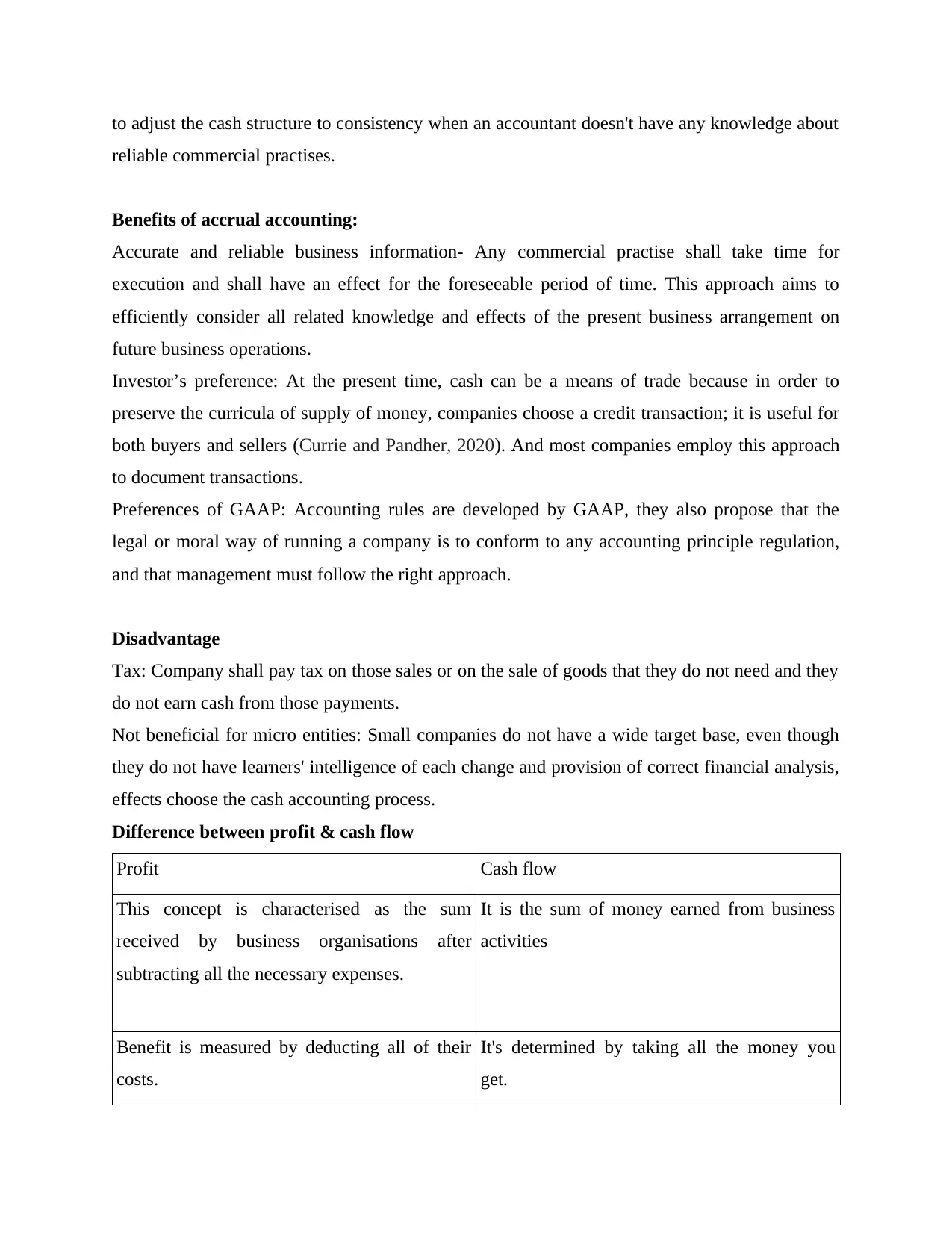
to adjust the cash structure to consistency when an accountant doesn't have any knowledge about
reliable commercial practises.
Benefits of accrual accounting:
Accurate and reliable business information- Any commercial practise shall take time for
execution and shall have an effect for the foreseeable period of time. This approach aims to
efficiently consider all related knowledge and effects of the present business arrangement on
future business operations.
Investor’s preference: At the present time, cash can be a means of trade because in order to
preserve the curricula of supply of money, companies choose a credit transaction; it is useful for
both buyers and sellers (Currie and Pandher, 2020). And most companies employ this approach
to document transactions.
Preferences of GAAP: Accounting rules are developed by GAAP, they also propose that the
legal or moral way of running a company is to conform to any accounting principle regulation,
and that management must follow the right approach.
Disadvantage
Tax: Company shall pay tax on those sales or on the sale of goods that they do not need and they
do not earn cash from those payments.
Not beneficial for micro entities: Small companies do not have a wide target base, even though
they do not have learners' intelligence of each change and provision of correct financial analysis,
effects choose the cash accounting process.
Difference between profit & cash flow
Profit Cash flow
This concept is characterised as the sum
received by business organisations after
subtracting all the necessary expenses.
It is the sum of money earned from business
activities
Benefit is measured by deducting all of their
costs.
It's determined by taking all the money you
get.
reliable commercial practises.
Benefits of accrual accounting:
Accurate and reliable business information- Any commercial practise shall take time for
execution and shall have an effect for the foreseeable period of time. This approach aims to
efficiently consider all related knowledge and effects of the present business arrangement on
future business operations.
Investor’s preference: At the present time, cash can be a means of trade because in order to
preserve the curricula of supply of money, companies choose a credit transaction; it is useful for
both buyers and sellers (Currie and Pandher, 2020). And most companies employ this approach
to document transactions.
Preferences of GAAP: Accounting rules are developed by GAAP, they also propose that the
legal or moral way of running a company is to conform to any accounting principle regulation,
and that management must follow the right approach.
Disadvantage
Tax: Company shall pay tax on those sales or on the sale of goods that they do not need and they
do not earn cash from those payments.
Not beneficial for micro entities: Small companies do not have a wide target base, even though
they do not have learners' intelligence of each change and provision of correct financial analysis,
effects choose the cash accounting process.
Difference between profit & cash flow
Profit Cash flow
This concept is characterised as the sum
received by business organisations after
subtracting all the necessary expenses.
It is the sum of money earned from business
activities
Benefit is measured by deducting all of their
costs.
It's determined by taking all the money you
get.
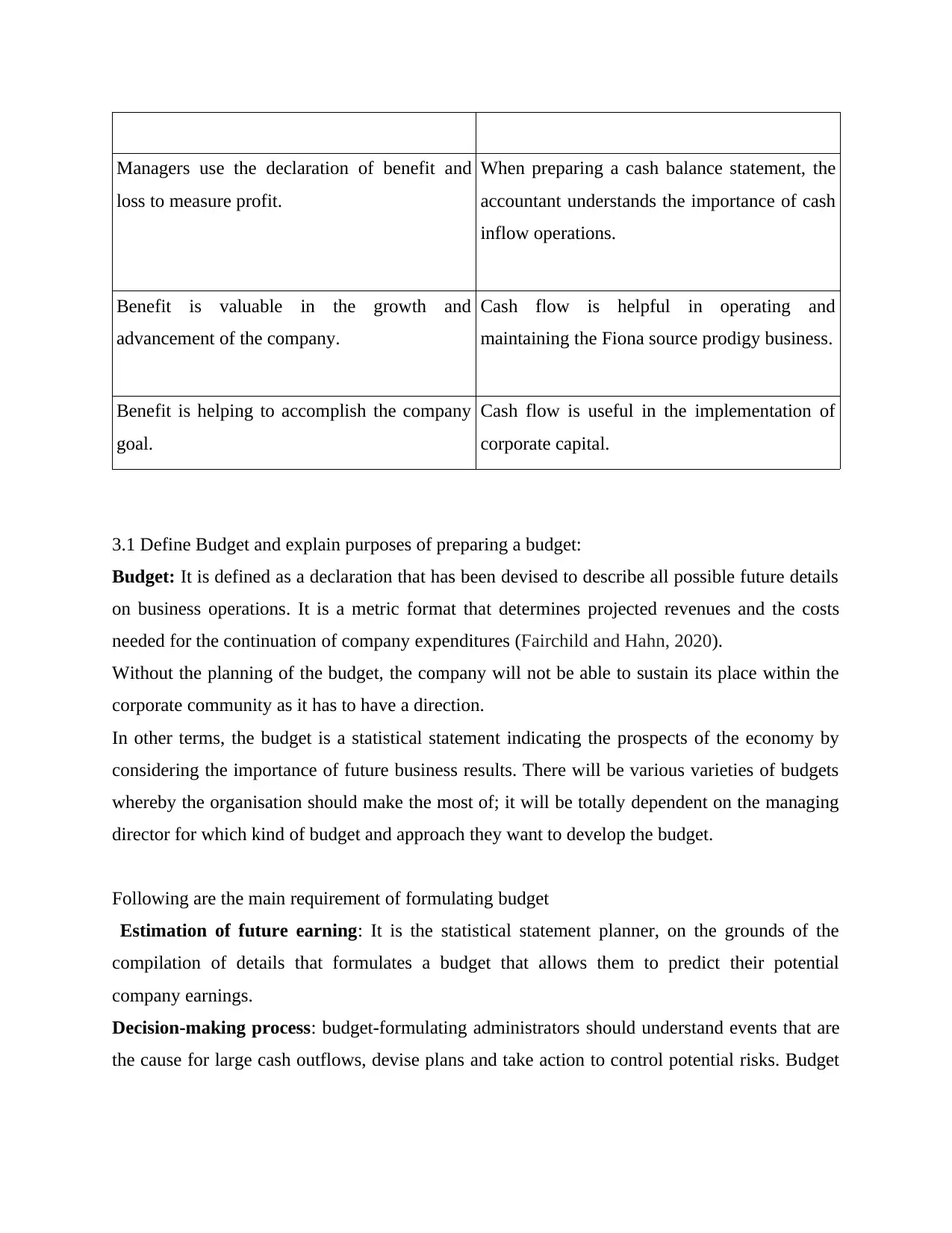
Managers use the declaration of benefit and
loss to measure profit.
When preparing a cash balance statement, the
accountant understands the importance of cash
inflow operations.
Benefit is valuable in the growth and
advancement of the company.
Cash flow is helpful in operating and
maintaining the Fiona source prodigy business.
Benefit is helping to accomplish the company
goal.
Cash flow is useful in the implementation of
corporate capital.
3.1 Define Budget and explain purposes of preparing a budget:
Budget: It is defined as a declaration that has been devised to describe all possible future details
on business operations. It is a metric format that determines projected revenues and the costs
needed for the continuation of company expenditures (Fairchild and Hahn, 2020).
Without the planning of the budget, the company will not be able to sustain its place within the
corporate community as it has to have a direction.
In other terms, the budget is a statistical statement indicating the prospects of the economy by
considering the importance of future business results. There will be various varieties of budgets
whereby the organisation should make the most of; it will be totally dependent on the managing
director for which kind of budget and approach they want to develop the budget.
Following are the main requirement of formulating budget
Estimation of future earning: It is the statistical statement planner, on the grounds of the
compilation of details that formulates a budget that allows them to predict their potential
company earnings.
Decision-making process: budget-formulating administrators should understand events that are
the cause for large cash outflows, devise plans and take action to control potential risks. Budget
loss to measure profit.
When preparing a cash balance statement, the
accountant understands the importance of cash
inflow operations.
Benefit is valuable in the growth and
advancement of the company.
Cash flow is helpful in operating and
maintaining the Fiona source prodigy business.
Benefit is helping to accomplish the company
goal.
Cash flow is useful in the implementation of
corporate capital.
3.1 Define Budget and explain purposes of preparing a budget:
Budget: It is defined as a declaration that has been devised to describe all possible future details
on business operations. It is a metric format that determines projected revenues and the costs
needed for the continuation of company expenditures (Fairchild and Hahn, 2020).
Without the planning of the budget, the company will not be able to sustain its place within the
corporate community as it has to have a direction.
In other terms, the budget is a statistical statement indicating the prospects of the economy by
considering the importance of future business results. There will be various varieties of budgets
whereby the organisation should make the most of; it will be totally dependent on the managing
director for which kind of budget and approach they want to develop the budget.
Following are the main requirement of formulating budget
Estimation of future earning: It is the statistical statement planner, on the grounds of the
compilation of details that formulates a budget that allows them to predict their potential
company earnings.
Decision-making process: budget-formulating administrators should understand events that are
the cause for large cash outflows, devise plans and take action to control potential risks. Budget
You're viewing a preview
Unlock full access by subscribing today!
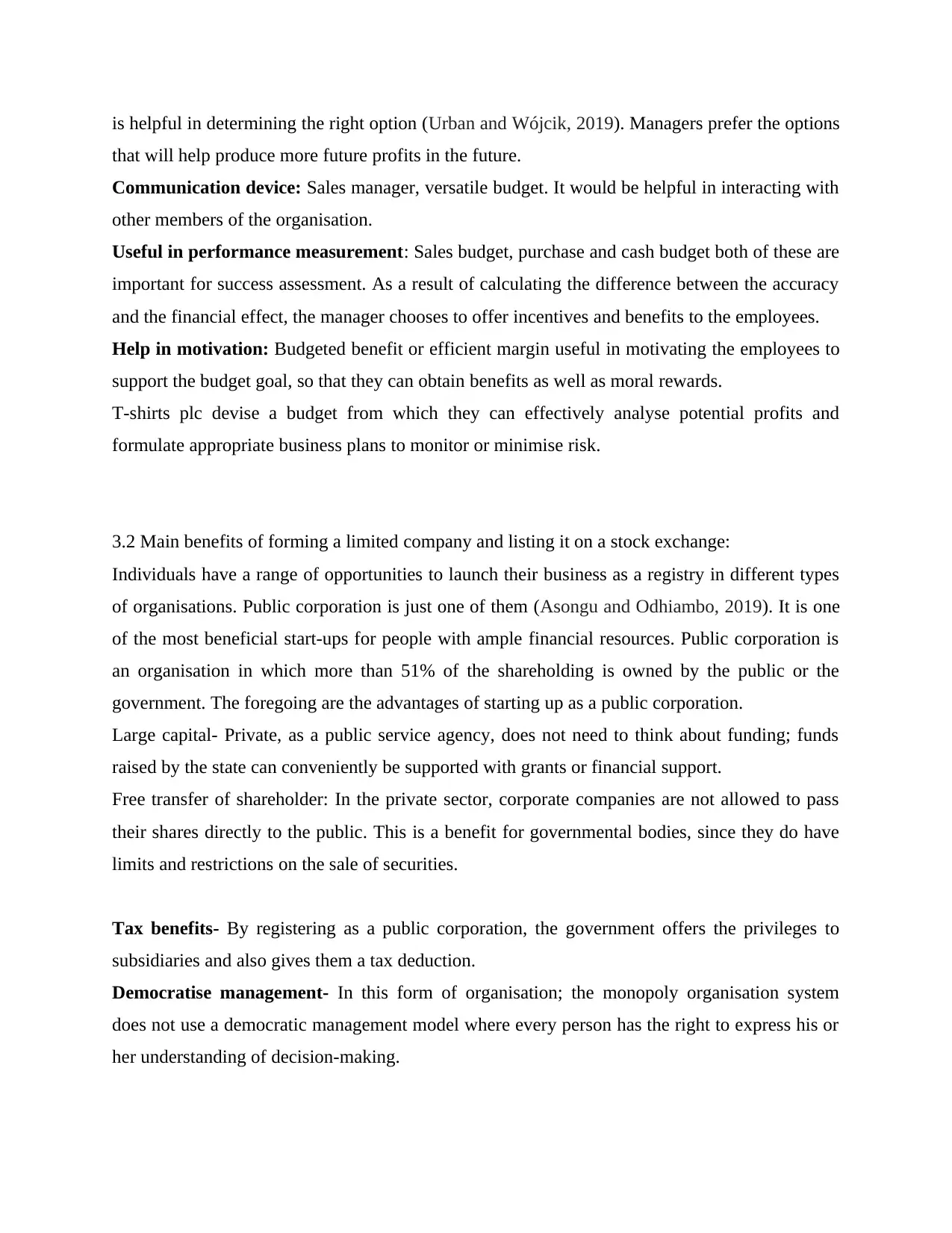
is helpful in determining the right option (Urban and Wójcik, 2019). Managers prefer the options
that will help produce more future profits in the future.
Communication device: Sales manager, versatile budget. It would be helpful in interacting with
other members of the organisation.
Useful in performance measurement: Sales budget, purchase and cash budget both of these are
important for success assessment. As a result of calculating the difference between the accuracy
and the financial effect, the manager chooses to offer incentives and benefits to the employees.
Help in motivation: Budgeted benefit or efficient margin useful in motivating the employees to
support the budget goal, so that they can obtain benefits as well as moral rewards.
T-shirts plc devise a budget from which they can effectively analyse potential profits and
formulate appropriate business plans to monitor or minimise risk.
3.2 Main benefits of forming a limited company and listing it on a stock exchange:
Individuals have a range of opportunities to launch their business as a registry in different types
of organisations. Public corporation is just one of them (Asongu and Odhiambo, 2019). It is one
of the most beneficial start-ups for people with ample financial resources. Public corporation is
an organisation in which more than 51% of the shareholding is owned by the public or the
government. The foregoing are the advantages of starting up as a public corporation.
Large capital- Private, as a public service agency, does not need to think about funding; funds
raised by the state can conveniently be supported with grants or financial support.
Free transfer of shareholder: In the private sector, corporate companies are not allowed to pass
their shares directly to the public. This is a benefit for governmental bodies, since they do have
limits and restrictions on the sale of securities.
Tax benefits- By registering as a public corporation, the government offers the privileges to
subsidiaries and also gives them a tax deduction.
Democratise management- In this form of organisation; the monopoly organisation system
does not use a democratic management model where every person has the right to express his or
her understanding of decision-making.
that will help produce more future profits in the future.
Communication device: Sales manager, versatile budget. It would be helpful in interacting with
other members of the organisation.
Useful in performance measurement: Sales budget, purchase and cash budget both of these are
important for success assessment. As a result of calculating the difference between the accuracy
and the financial effect, the manager chooses to offer incentives and benefits to the employees.
Help in motivation: Budgeted benefit or efficient margin useful in motivating the employees to
support the budget goal, so that they can obtain benefits as well as moral rewards.
T-shirts plc devise a budget from which they can effectively analyse potential profits and
formulate appropriate business plans to monitor or minimise risk.
3.2 Main benefits of forming a limited company and listing it on a stock exchange:
Individuals have a range of opportunities to launch their business as a registry in different types
of organisations. Public corporation is just one of them (Asongu and Odhiambo, 2019). It is one
of the most beneficial start-ups for people with ample financial resources. Public corporation is
an organisation in which more than 51% of the shareholding is owned by the public or the
government. The foregoing are the advantages of starting up as a public corporation.
Large capital- Private, as a public service agency, does not need to think about funding; funds
raised by the state can conveniently be supported with grants or financial support.
Free transfer of shareholder: In the private sector, corporate companies are not allowed to pass
their shares directly to the public. This is a benefit for governmental bodies, since they do have
limits and restrictions on the sale of securities.
Tax benefits- By registering as a public corporation, the government offers the privileges to
subsidiaries and also gives them a tax deduction.
Democratise management- In this form of organisation; the monopoly organisation system
does not use a democratic management model where every person has the right to express his or
her understanding of decision-making.
Paraphrase This Document
Need a fresh take? Get an instant paraphrase of this document with our AI Paraphraser
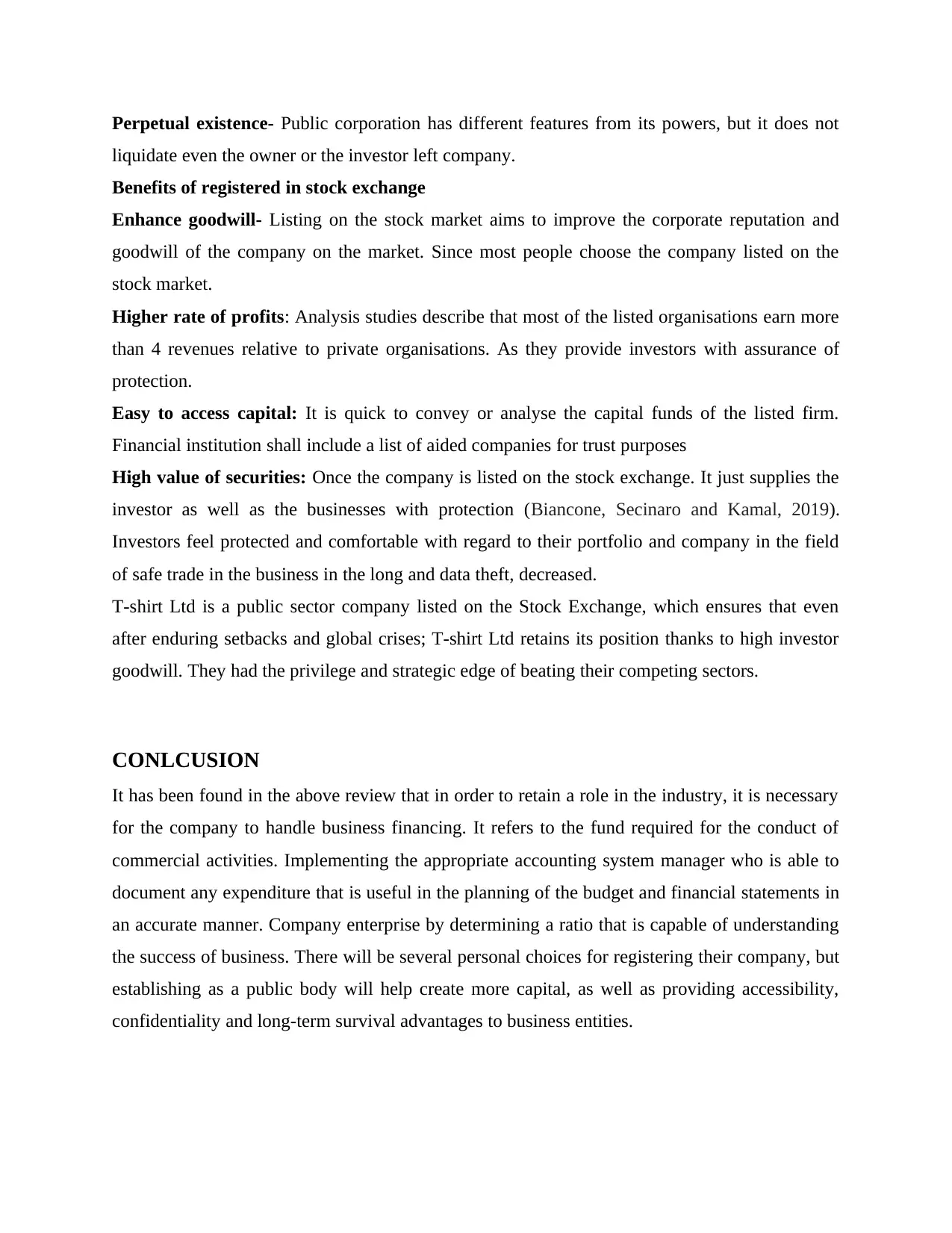
Perpetual existence- Public corporation has different features from its powers, but it does not
liquidate even the owner or the investor left company.
Benefits of registered in stock exchange
Enhance goodwill- Listing on the stock market aims to improve the corporate reputation and
goodwill of the company on the market. Since most people choose the company listed on the
stock market.
Higher rate of profits: Analysis studies describe that most of the listed organisations earn more
than 4 revenues relative to private organisations. As they provide investors with assurance of
protection.
Easy to access capital: It is quick to convey or analyse the capital funds of the listed firm.
Financial institution shall include a list of aided companies for trust purposes
High value of securities: Once the company is listed on the stock exchange. It just supplies the
investor as well as the businesses with protection (Biancone, Secinaro and Kamal, 2019).
Investors feel protected and comfortable with regard to their portfolio and company in the field
of safe trade in the business in the long and data theft, decreased.
T-shirt Ltd is a public sector company listed on the Stock Exchange, which ensures that even
after enduring setbacks and global crises; T-shirt Ltd retains its position thanks to high investor
goodwill. They had the privilege and strategic edge of beating their competing sectors.
CONLCUSION
It has been found in the above review that in order to retain a role in the industry, it is necessary
for the company to handle business financing. It refers to the fund required for the conduct of
commercial activities. Implementing the appropriate accounting system manager who is able to
document any expenditure that is useful in the planning of the budget and financial statements in
an accurate manner. Company enterprise by determining a ratio that is capable of understanding
the success of business. There will be several personal choices for registering their company, but
establishing as a public body will help create more capital, as well as providing accessibility,
confidentiality and long-term survival advantages to business entities.
liquidate even the owner or the investor left company.
Benefits of registered in stock exchange
Enhance goodwill- Listing on the stock market aims to improve the corporate reputation and
goodwill of the company on the market. Since most people choose the company listed on the
stock market.
Higher rate of profits: Analysis studies describe that most of the listed organisations earn more
than 4 revenues relative to private organisations. As they provide investors with assurance of
protection.
Easy to access capital: It is quick to convey or analyse the capital funds of the listed firm.
Financial institution shall include a list of aided companies for trust purposes
High value of securities: Once the company is listed on the stock exchange. It just supplies the
investor as well as the businesses with protection (Biancone, Secinaro and Kamal, 2019).
Investors feel protected and comfortable with regard to their portfolio and company in the field
of safe trade in the business in the long and data theft, decreased.
T-shirt Ltd is a public sector company listed on the Stock Exchange, which ensures that even
after enduring setbacks and global crises; T-shirt Ltd retains its position thanks to high investor
goodwill. They had the privilege and strategic edge of beating their competing sectors.
CONLCUSION
It has been found in the above review that in order to retain a role in the industry, it is necessary
for the company to handle business financing. It refers to the fund required for the conduct of
commercial activities. Implementing the appropriate accounting system manager who is able to
document any expenditure that is useful in the planning of the budget and financial statements in
an accurate manner. Company enterprise by determining a ratio that is capable of understanding
the success of business. There will be several personal choices for registering their company, but
establishing as a public body will help create more capital, as well as providing accessibility,
confidentiality and long-term survival advantages to business entities.
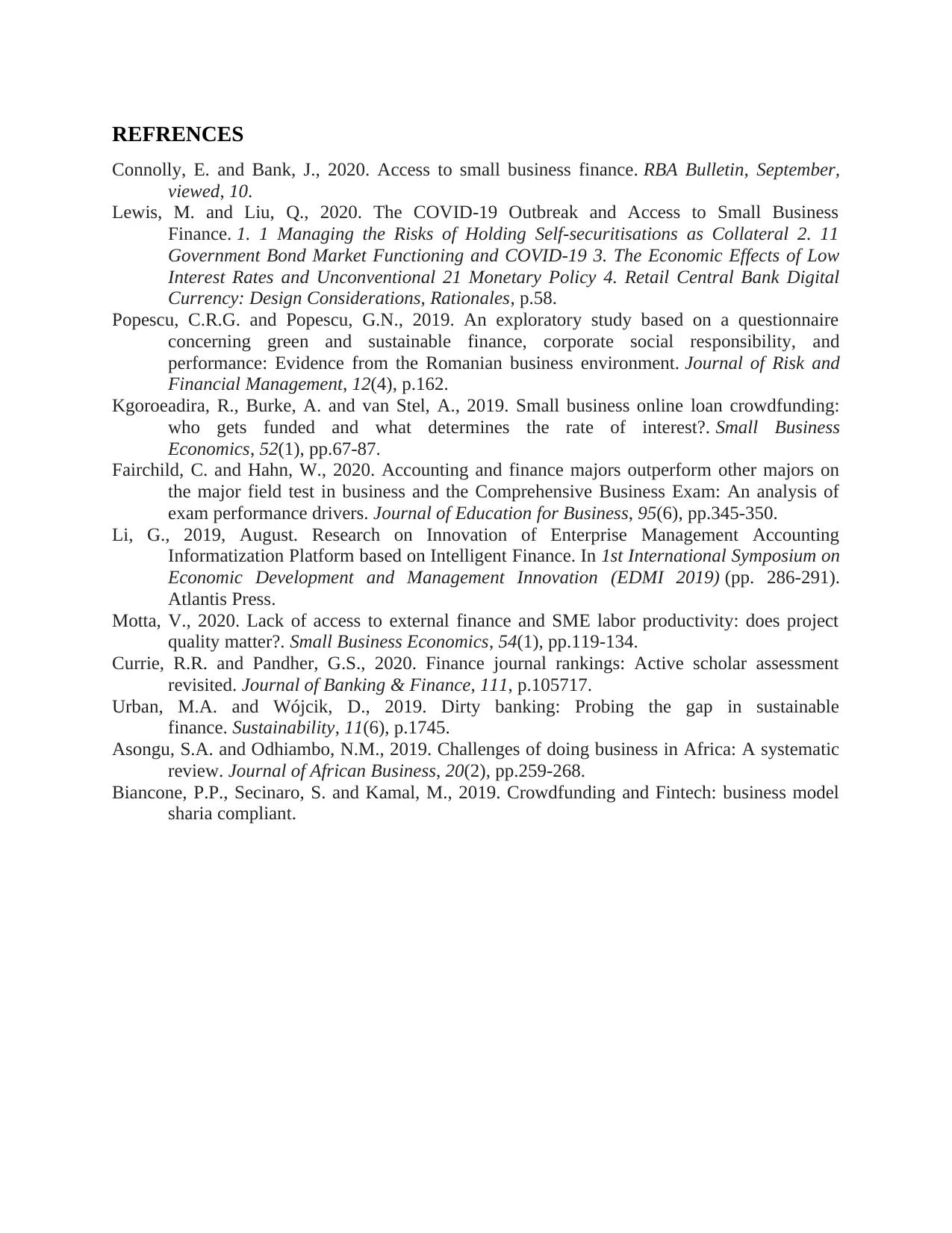
REFRENCES
Connolly, E. and Bank, J., 2020. Access to small business finance. RBA Bulletin, September,
viewed, 10.
Lewis, M. and Liu, Q., 2020. The COVID-19 Outbreak and Access to Small Business
Finance. 1. 1 Managing the Risks of Holding Self-securitisations as Collateral 2. 11
Government Bond Market Functioning and COVID-19 3. The Economic Effects of Low
Interest Rates and Unconventional 21 Monetary Policy 4. Retail Central Bank Digital
Currency: Design Considerations, Rationales, p.58.
Popescu, C.R.G. and Popescu, G.N., 2019. An exploratory study based on a questionnaire
concerning green and sustainable finance, corporate social responsibility, and
performance: Evidence from the Romanian business environment. Journal of Risk and
Financial Management, 12(4), p.162.
Kgoroeadira, R., Burke, A. and van Stel, A., 2019. Small business online loan crowdfunding:
who gets funded and what determines the rate of interest?. Small Business
Economics, 52(1), pp.67-87.
Fairchild, C. and Hahn, W., 2020. Accounting and finance majors outperform other majors on
the major field test in business and the Comprehensive Business Exam: An analysis of
exam performance drivers. Journal of Education for Business, 95(6), pp.345-350.
Li, G., 2019, August. Research on Innovation of Enterprise Management Accounting
Informatization Platform based on Intelligent Finance. In 1st International Symposium on
Economic Development and Management Innovation (EDMI 2019) (pp. 286-291).
Atlantis Press.
Motta, V., 2020. Lack of access to external finance and SME labor productivity: does project
quality matter?. Small Business Economics, 54(1), pp.119-134.
Currie, R.R. and Pandher, G.S., 2020. Finance journal rankings: Active scholar assessment
revisited. Journal of Banking & Finance, 111, p.105717.
Urban, M.A. and Wójcik, D., 2019. Dirty banking: Probing the gap in sustainable
finance. Sustainability, 11(6), p.1745.
Asongu, S.A. and Odhiambo, N.M., 2019. Challenges of doing business in Africa: A systematic
review. Journal of African Business, 20(2), pp.259-268.
Biancone, P.P., Secinaro, S. and Kamal, M., 2019. Crowdfunding and Fintech: business model
sharia compliant.
Connolly, E. and Bank, J., 2020. Access to small business finance. RBA Bulletin, September,
viewed, 10.
Lewis, M. and Liu, Q., 2020. The COVID-19 Outbreak and Access to Small Business
Finance. 1. 1 Managing the Risks of Holding Self-securitisations as Collateral 2. 11
Government Bond Market Functioning and COVID-19 3. The Economic Effects of Low
Interest Rates and Unconventional 21 Monetary Policy 4. Retail Central Bank Digital
Currency: Design Considerations, Rationales, p.58.
Popescu, C.R.G. and Popescu, G.N., 2019. An exploratory study based on a questionnaire
concerning green and sustainable finance, corporate social responsibility, and
performance: Evidence from the Romanian business environment. Journal of Risk and
Financial Management, 12(4), p.162.
Kgoroeadira, R., Burke, A. and van Stel, A., 2019. Small business online loan crowdfunding:
who gets funded and what determines the rate of interest?. Small Business
Economics, 52(1), pp.67-87.
Fairchild, C. and Hahn, W., 2020. Accounting and finance majors outperform other majors on
the major field test in business and the Comprehensive Business Exam: An analysis of
exam performance drivers. Journal of Education for Business, 95(6), pp.345-350.
Li, G., 2019, August. Research on Innovation of Enterprise Management Accounting
Informatization Platform based on Intelligent Finance. In 1st International Symposium on
Economic Development and Management Innovation (EDMI 2019) (pp. 286-291).
Atlantis Press.
Motta, V., 2020. Lack of access to external finance and SME labor productivity: does project
quality matter?. Small Business Economics, 54(1), pp.119-134.
Currie, R.R. and Pandher, G.S., 2020. Finance journal rankings: Active scholar assessment
revisited. Journal of Banking & Finance, 111, p.105717.
Urban, M.A. and Wójcik, D., 2019. Dirty banking: Probing the gap in sustainable
finance. Sustainability, 11(6), p.1745.
Asongu, S.A. and Odhiambo, N.M., 2019. Challenges of doing business in Africa: A systematic
review. Journal of African Business, 20(2), pp.259-268.
Biancone, P.P., Secinaro, S. and Kamal, M., 2019. Crowdfunding and Fintech: business model
sharia compliant.
You're viewing a preview
Unlock full access by subscribing today!
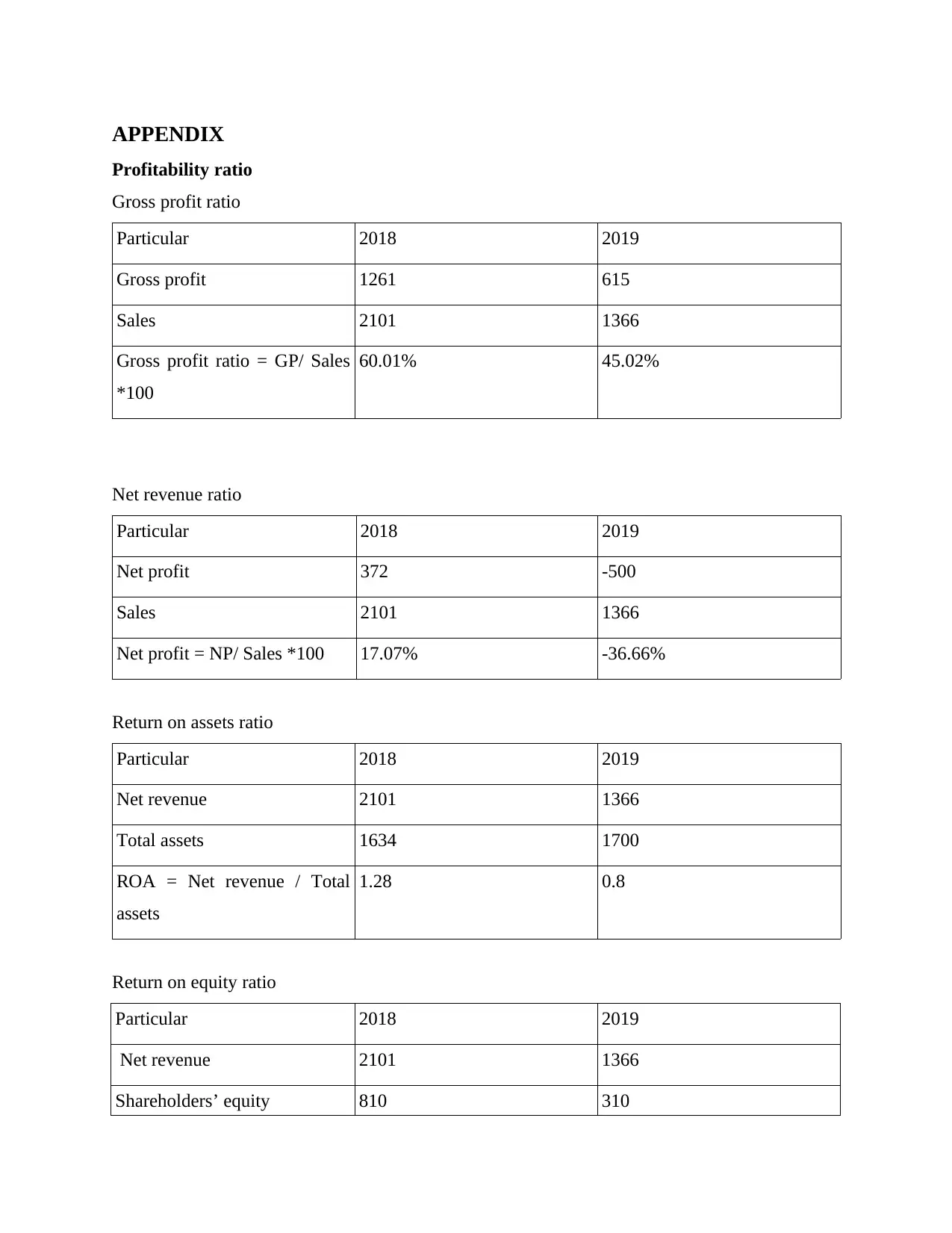
APPENDIX
Profitability ratio
Gross profit ratio
Particular 2018 2019
Gross profit 1261 615
Sales 2101 1366
Gross profit ratio = GP/ Sales
*100
60.01% 45.02%
Net revenue ratio
Particular 2018 2019
Net profit 372 -500
Sales 2101 1366
Net profit = NP/ Sales *100 17.07% -36.66%
Return on assets ratio
Particular 2018 2019
Net revenue 2101 1366
Total assets 1634 1700
ROA = Net revenue / Total
assets
1.28 0.8
Return on equity ratio
Particular 2018 2019
Net revenue 2101 1366
Shareholders’ equity 810 310
Profitability ratio
Gross profit ratio
Particular 2018 2019
Gross profit 1261 615
Sales 2101 1366
Gross profit ratio = GP/ Sales
*100
60.01% 45.02%
Net revenue ratio
Particular 2018 2019
Net profit 372 -500
Sales 2101 1366
Net profit = NP/ Sales *100 17.07% -36.66%
Return on assets ratio
Particular 2018 2019
Net revenue 2101 1366
Total assets 1634 1700
ROA = Net revenue / Total
assets
1.28 0.8
Return on equity ratio
Particular 2018 2019
Net revenue 2101 1366
Shareholders’ equity 810 310
Paraphrase This Document
Need a fresh take? Get an instant paraphrase of this document with our AI Paraphraser
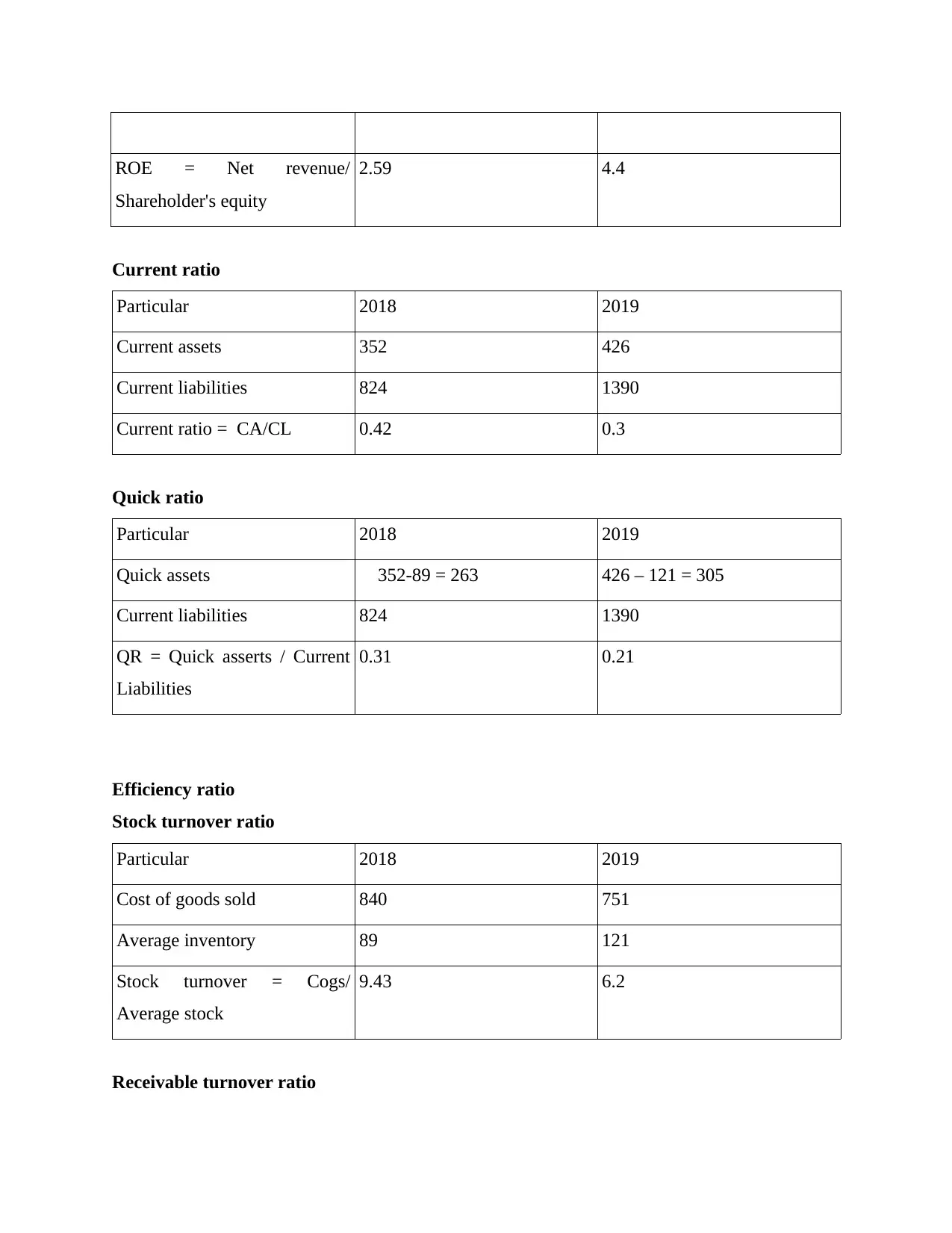
ROE = Net revenue/
Shareholder's equity
2.59 4.4
Current ratio
Particular 2018 2019
Current assets 352 426
Current liabilities 824 1390
Current ratio = CA/CL 0.42 0.3
Quick ratio
Particular 2018 2019
Quick assets 352-89 = 263 426 – 121 = 305
Current liabilities 824 1390
QR = Quick asserts / Current
Liabilities
0.31 0.21
Efficiency ratio
Stock turnover ratio
Particular 2018 2019
Cost of goods sold 840 751
Average inventory 89 121
Stock turnover = Cogs/
Average stock
9.43 6.2
Receivable turnover ratio
Shareholder's equity
2.59 4.4
Current ratio
Particular 2018 2019
Current assets 352 426
Current liabilities 824 1390
Current ratio = CA/CL 0.42 0.3
Quick ratio
Particular 2018 2019
Quick assets 352-89 = 263 426 – 121 = 305
Current liabilities 824 1390
QR = Quick asserts / Current
Liabilities
0.31 0.21
Efficiency ratio
Stock turnover ratio
Particular 2018 2019
Cost of goods sold 840 751
Average inventory 89 121
Stock turnover = Cogs/
Average stock
9.43 6.2
Receivable turnover ratio
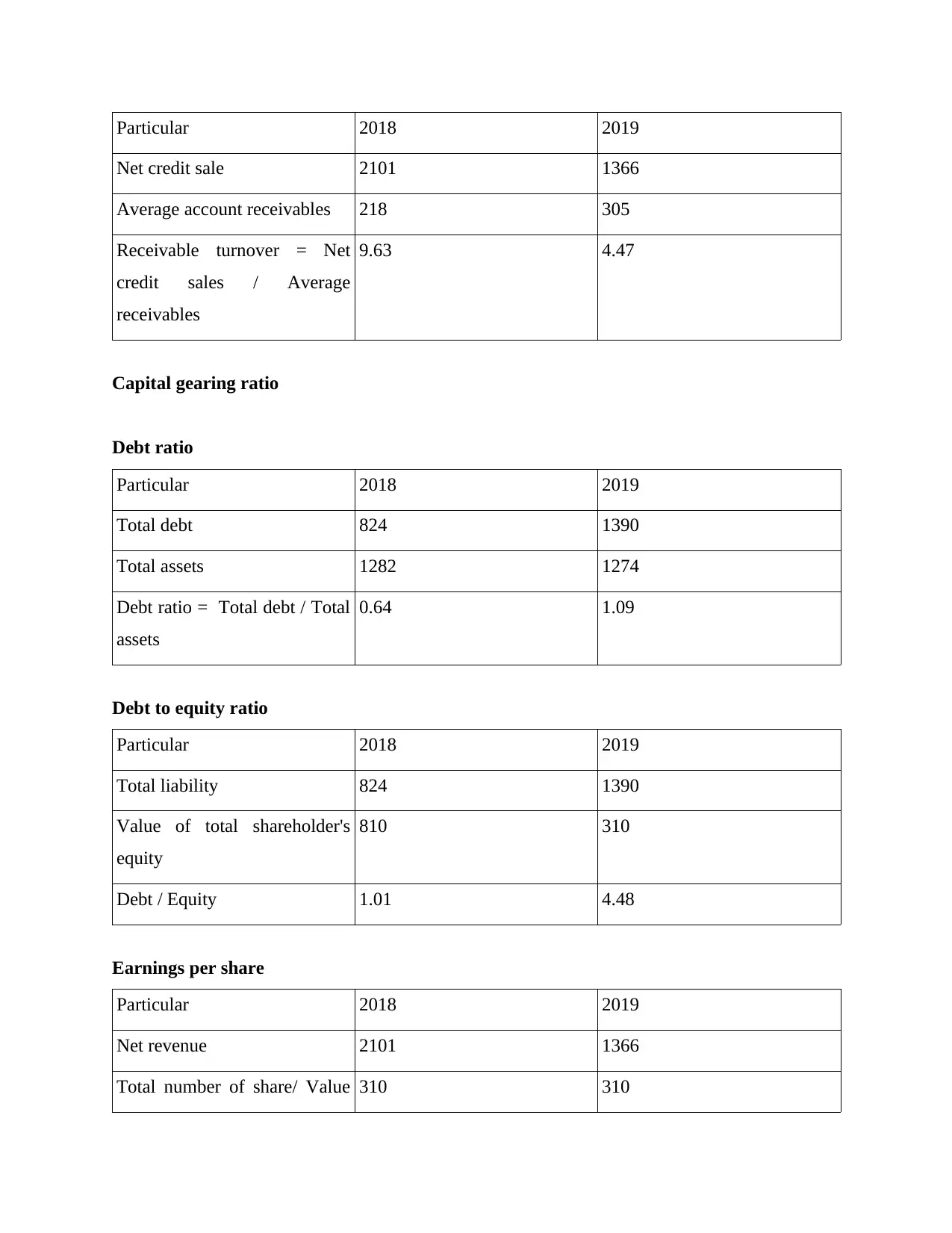
Particular 2018 2019
Net credit sale 2101 1366
Average account receivables 218 305
Receivable turnover = Net
credit sales / Average
receivables
9.63 4.47
Capital gearing ratio
Debt ratio
Particular 2018 2019
Total debt 824 1390
Total assets 1282 1274
Debt ratio = Total debt / Total
assets
0.64 1.09
Debt to equity ratio
Particular 2018 2019
Total liability 824 1390
Value of total shareholder's
equity
810 310
Debt / Equity 1.01 4.48
Earnings per share
Particular 2018 2019
Net revenue 2101 1366
Total number of share/ Value 310 310
Net credit sale 2101 1366
Average account receivables 218 305
Receivable turnover = Net
credit sales / Average
receivables
9.63 4.47
Capital gearing ratio
Debt ratio
Particular 2018 2019
Total debt 824 1390
Total assets 1282 1274
Debt ratio = Total debt / Total
assets
0.64 1.09
Debt to equity ratio
Particular 2018 2019
Total liability 824 1390
Value of total shareholder's
equity
810 310
Debt / Equity 1.01 4.48
Earnings per share
Particular 2018 2019
Net revenue 2101 1366
Total number of share/ Value 310 310
You're viewing a preview
Unlock full access by subscribing today!

of share
EPS = Net revenue/ Number of
share
6.77 4.4
EPS = Net revenue/ Number of
share
6.77 4.4
1 out of 16
Related Documents
Your All-in-One AI-Powered Toolkit for Academic Success.
+13062052269
info@desklib.com
Available 24*7 on WhatsApp / Email
![[object Object]](/_next/static/media/star-bottom.7253800d.svg)
Unlock your academic potential
© 2024 | Zucol Services PVT LTD | All rights reserved.





